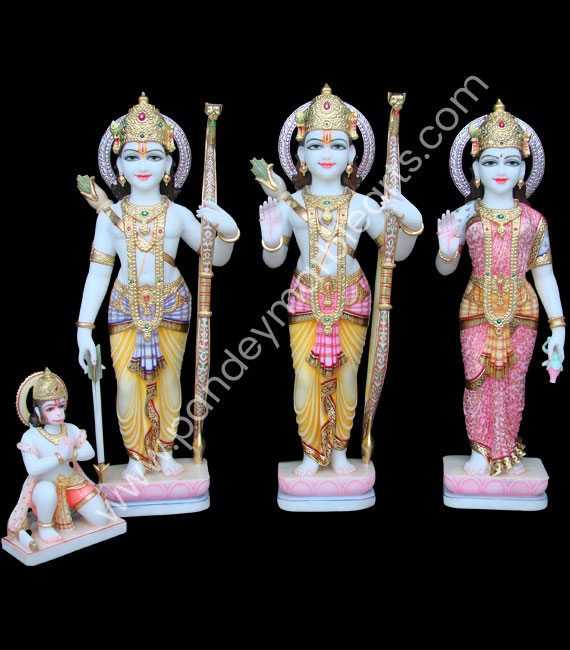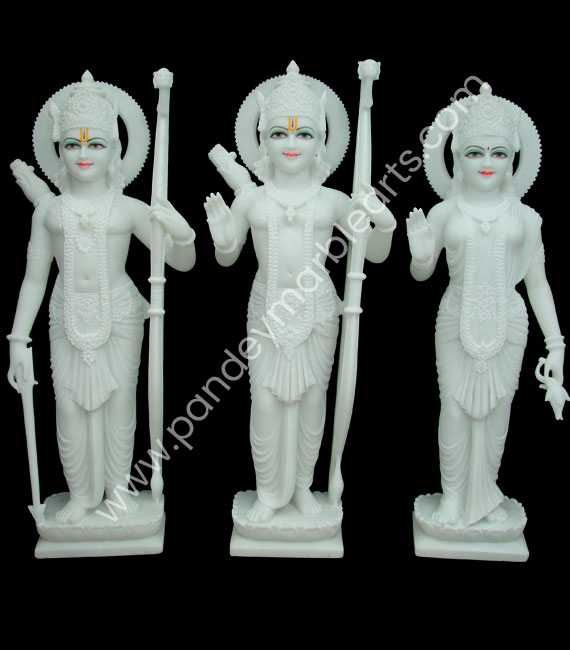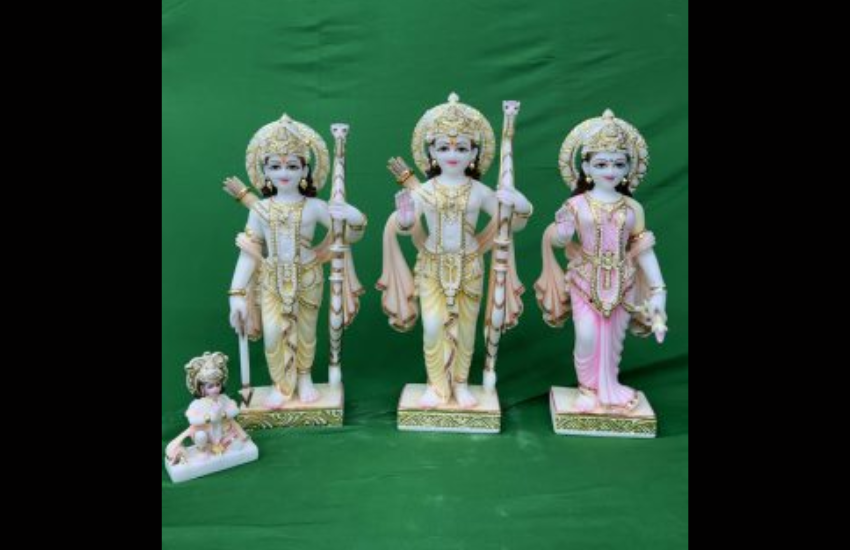What’s more blissful and divine than the thought of bringing the Ram Darbar marble statue to your home? The positivity, blessings, and sacredness it adds to your space are something that can’t be expressed in words but can be deeply felt in your surroundings and spirit.
A Ram Parivar marble moorti is a sacred representation of Lord Ram and his family, including Mata Sita, Lakshmana, and Hanuman. Together, they symbolize dharma, love, loyalty, and devotion. But to truly invite the blessings of the marble Ram Darbar idol, it should be placed following Vastu principles so that its divine energy flows through your home.
Through this guide, we will help you understand the significance of placing Ram Darbar at home, what you should do, and what to avoid. With every little information handy, you can welcome peace, prosperity, and spiritual balance into your space.
Who are the Deities in the Ram Darbar and What Do They Represent?
Ram Darbar, often called Ram Rajya, refers to the assembly of Lord Rama where he is seated on the throne of Ayodhya with his consort Maa Sita, brother Lakshmana, and devotee Hanuman. It symbolizes an ideal state of justice, peace, and righteousness.
The Ram Darbar idol depicts the coronation of Lord Rama after returning from exile (vanvas) with Devi Sita, Laxman, and Hanuman. The deities in the Ram Darbar idol include:
1). Lord Rama
Ramachandra is the 7th incarnation of Lord Vishnu and the king of Ayodhya. The purpose of Lord Vishnu taking a human incarnation (avatar) was to uphold virtue and stand for dharma. He showcased the ideal leadership, companionship, and triumph of good over evil after killing the demon king of Lanka, Ravana.
2). Devi Sita
Maa Sita is the wife of Lord Rama and is typically depicted to the left of him. She is the epitome of loyalty and is said to be the incarnation of the goddess Lakshmi. Her life portrays unfaltering devotion and faithfulness towards her husband, Rama.
3). Lakshmana
Lakshmana is the half-brother of Lord Rama and is considered the incarnation of Shesha, the serpent lord on whom Lord Vishnu rests. Lakshmana’s character showcases the loyalty and commitment to offering selfless service to his elder brother Rama.
4). Lord Hanuman
Hanuman is the true devotee of Lord Rama and was born to aid him in his challenges to rescue Mata Sita from Ravana. He accompanied Ram and Lakshman to win the battle. He is one of the most powerful deities in Hinduism and is believed to be an incarnation (avatar) of Lord Shiva. The Hanuman statue in Ram Darbar, kneeling posture with folded hands facing towards Lord Rama, symbolizes his devotion, surrender, and loyalty to Ram and Sita.

While the Ram Darbar traditionally features four deities, Shri Ram, Sita, Lakshman, and Hanuman, many devotees also choose to include Bharat and Shatrughan to complete the divine presence of all four brothers, symbolizing unity and righteousness in the royal family.
5). Bharat
Bharat is the epitome of pure devotion and unconditional love. He declined the crown when Shri Ram was sent into exile and instead became a caretaker king, putting Ram’s sandals on the throne. His presence in Ram Darbar idol symbolizes humbleness, sacrifice, and total respect for dharma.
6). Shatrughna
Shatrughna, the youngest brother, symbolizes quiet strength and obedient service. Though less spoken of, his role was vital in supporting the kingdom, standing by Bharat, and fulfilling responsibilities without seeking recognition. He embodies loyalty, calm wisdom, and inner devotion.
Dos of Placing a Ram Darbar Marble Statue at Home
For those planning to welcome Shree Ram with a Family moorti at home, it is important to follow placement guidelines as per Vastu Shastra to truly experience its positive energy.
Here are the Vastu tips for placing the Marble Ram Darbar Murti at home:
Choose the Right Direction
Always position the seated Ram Sita marble moorti in the northeast direction of your home. This is referred to as the Ishan corner and is considered highly sacred and full of positivity. It provides peace, harmony, and positive vibes when a divine idol is placed here.
Make Sure the Idols Face the Right Way
The Ram Darbar murti must be oriented towards the east or west. The directions are said to bring good vibes. Never position the murti in such a way that it is facing south because it is not considered auspicious according to Vastu.
Use a Proper Platform (Chowki)
Never leave the Hindu gods’ marble murti on the floor directly. Put them on a clean wooden or marble chowki. This is a sign of respect and also makes the area around the idol pure. You can keep a small decorative cloth under the chowki as well.
Keep the Space Clean and Peaceful
The space where you place the Ram Darbar should always remain clean, neat, and quiet. Don’t put it near washrooms, bedrooms, or staircases, as they are not pure places. It is often recommended to place the Ram Sita Lakshman Hanuman idol in a home temple.
Worship Daily with Devotion
Always perform daily puja by lighting a diya and incense sticks. You should also offer flowers, fruits, or sweets. Even a few minutes of prayer relaxes and makes you connected with divine energy.
Keep the Right Height for the Idol
Keep the idol at a height that is at your eye level or just above when sitting for prayer. This allows for better focus and connection during worship. Don’t place it too high or too low.
Things You Must Avoid While Placing Ram Darbar at Home
To truly welcome the blessings of deities through marble god statues, it is important to know what not to do while placing them. Certain placements or practices may block the positive energy and reduce the spiritual impact.
Do Not Keep Broken or Damaged Idols
If the Ram Darbar murti or a portion of it is cracked or chipped, it must not be brought home. It is believed to trap good energy. Instead, reverently submerge it in a river or leave it beneath a holy tree.
Do not Place It in the South Direction
Never keep the Ram Darbar murti facing the south direction. The direction is not good for putting gods and can upset the calm energy.
Do Not Place It in the Kitchen or Bedroom
The murti must not be placed in bedrooms, kitchens, or adjacent to bathrooms. These are impure and not suitable for devotion.
Do Not Place It Directly on the Floor
Keep the murti on a clean platform or chowki at all times. Putting it on the floor is considered disrespectful.
Why Is It Important to Place Ram Darbar Correctly at Home?
An incorrect placement, such as placing the Ram Mandir statue close to the bathroom or in the incorrect direction, can obstruct the good energy and disturb the serenity of the atmosphere. Vastu assists in determining the best direction and location, so the divine power flows freely and maintains your home peaceful and filled with good energy.
It also manifests our respect towards the gods when we provide them with a clean, peaceful, and proper location. Simply by following simple Vastu principles, you bring positivity, devotion, and blessings into your life. That’s why correctly placing Ram Darbar is so significant.

What Rituals are Associated with Worshipping the Ram Darbar Idol?
Worshipping the Ram Darbar marble murti at home is one of the peaceful ways to invite blessings and positivity into your life. The most prominent ritual is performing daily puja. Start by cleaning the place and lighting a diya (oil lamp) and an incense stick. Also, offer fresh flowers, fruits, or sweets to the gods.
You can also chant Ram bhajans or mantras such as “Shri Ram Jai Ram Jai Jai Ram.” Performing aarti with devotion in the morning or evening is a fine practice. Cleanse the idols and adorn them with fresh cloth or garlands every day.
On auspicious days like Ram Navami and Diwali, you can perform a puja with prayers, sweets, and singing bhajans. Also, sit quietly for a few minutes after the puja and feel calm and grateful.
These little daily routines aid in establishing calm in the home and instill a profound spiritual bond with Lord Ram and his divine family.
How Should You Care for and Maintain a Marble Ram Darbar Statue?
Taking good care of your Ram Darbar Marble statue helps keep its shine, beauty, and spiritual potency. Gently clean the idol with a soft dry cloth every few days to remove dust. Avoid using strong cleaners or too much water, as marble is soft and can get damaged.
To regain the natural shine of marble statues, it is recommended to get them polished from time to time. This gives the statue a new look and also enhances its divine aura. Polishing and repainting of marble moorti should always be carried out by skilled sculptors, as they know how to treat the statue with care without damaging it.
Also, maintain the surrounding area of the idol clean and adorned with fresh flowers and cloth. Replace offerings frequently and refrain from putting waste or footwear close to the murti.
Conclusion
Having a Ram Darbar marble statue at home fills your life with peace, love, and blessings. But to experience its beneficial energy to the fullest, it is essential to place it in the correct way, following simple Vastu guidelines. It makes your home a peaceful and joyful place.
If you are planning to bring home a Ram Darbar marble murti, Pandey Moorti Bhandar stands out with its unmatched artistry and devotion. Their exceptional craftsmanship was honored when their Ram Darbar statue was ceremonially installed in the sanctum sanctorum of the grand Ram Mandir in Ayodhya on the auspicious day of Ganga Dashmi on June 05, 2025.
FAQs
What is the Meaning of Ram Darbar?
Ram Darbar means the divine court of Lord Ram, wherein he is depicted with Maa Sita, Lakshman, and Hanuman, representing peace, love, duty, and devotion.
Can We Keep Ram Darbar Murti at Home?
Yes, you can. The Ram Darbar murti placed at home brings blessings, harmony, and positive energy when kept and worshipped in a respectful and devoted manner.
In Which Direction Should We Keep RAM Darbar?
According to Vastu, position the Ram Darbar idol in the east or northeast direction of your home temple, facing east or west for maximum spiritual gain.
Can I Keep the Ram Lalla Idol at Home?
Yes, you can have a Ram Lalla idol at home. It must be taken care of with devotion and placed respectfully in your home temple or pooja room.
Can We Keep Marble Idols at Home Temples?
Yes, definitely. Marble idols are pure and sacred. Many of them are used in home temples for their beauty and spiritual powers.
What is the Significance of Ram Darbar at Home?
Ram Darbar at home symbolizes family togetherness, piety, and protection. It grants godly blessings, tranquility, and an atmosphere of spiritual wholeness to your home.
Who Made Ram Darbar at Ayodhya Ram Mandir?
The Ram Darbar at Ayodhya Ram Mandir was crafted by renowned Jaipur-based sculptor Satya Narain Pandey and the entire Pandey Moorti Bhandar team in Jaipur. They used pure white Makrana marble to carve the idols with exceptional detail and devotion.

